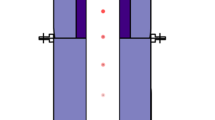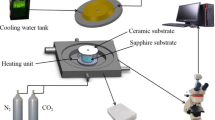Abstract
Co-gasification of industrial sludge (IS) and coal was an effective approach to achieve harmless and sustainable utilization of IS. The long-term and stable operation of a co-gasification largely depends on fluidity of coal-ash slag. Herein, the effects of IS addition on the crystallization and viscosity of Shuangmazao (SMZ) coal were investigated by means of high temperature stage coupled with an optical microscope (HTSOM), a scanning electron microscopy coupled with an energy dispersive X-ray spectrometry (SEM-EDS), X-ray diffraction (XRD), a Fourier transform infrared spectrometer (FTIR), and FactSage software. The results showed that when the proportion of IS was less than 60%, with the addition of IS, the slag existed in an amorphous form. This was due to the high content of SiO2 and Al2O3 in SMZ ash and blended ash, which had a high glass-forming ability (GFA). The slag formed at a high temperature had a higher polymerization degree and viscosity, which led to a decrease in the migration ability between ions, and ultimately made the slag difficult to crystallize during the cooling. When the proportion of IS was higher than 60%, the addition of IS increased the CaO and FeO content in the system. As network modifiers, CaO and FeO could provide O2− at a high temperature, which reacted with silicate network structure and continuously destroyed the complexity of network structure, thus reducing the polymerization degree and viscosity of slag. At this time, the migration ability between ions was enhanced, and needle-shaped/rod-shaped crystals were precipitated during the cooling process. Finally, the viscosity calculated by simulation and Einstein-Roscoe empirical formula demonstrated that the addition of IS could significantly improve the fluidity of coal ash and meet the requirements of the liquid slag-tapping gasifier. The purpose of this work was to provide theoretical support for slag flow mechanisms during the gasifier slagging-tapping process and the resource treatment of industrial solid waste.
Similar content being viewed by others
References
Rulkens W. Sewage sludge as a biomass resource for the production of energy: overview and assessment of the various options. Energy & Fuels, 2008, 22(1): 9–15
Goswami R, Das R. Waste heat recovery from a biomass heat engine for thermoelectric power generation using two-phase thermosyphons. Renewable Energy, 2020, 148: 1280–1291
Goswami R, Das R. Energy cogeneration study of red mulberry (Morus rubra)-based biomass. Energy Sources. Part A, Recovery, Utilization, and Environmental Effects, 2020, 42(8): 979–1000
Kijo-Kleczkowska A, Sroda K, Kosowska-Golachowska M, et al. Experimental research of sewage sludge with coal and biomass co-combustion, in pellet form. Waste Management (New York, N.Y.), 2016, 53: 165–181
Deng N, Li D Y, Zhang Q, et al. Simulation analysis of municipal solid waste pyrolysis and gasification based on Aspen plus. Frontiers in Energy, 2019, 13(1): 64–70
Yue G, Lyu J, Li S. Clean and highly-efficient utilization of coal. Frontiers in Energy, 2021, 15(1): 1–3
Wang L, Skjevrak G, Hustad J E, et al. Sintering characteristics of sewage sludge ashes at elevated temperature. Fuel Processing Technology, 2012, 96: 88–97
Folgueras M B, Alonso M, Folgueras J R. Effect of sludge addition to coal on Na, K and S volatilisation in ashing process and ash fusibility. Fuel Processing Technology, 2015, 138: 714–723
Stickler D B, Gannon R E. Slag-coated wall structure technology for entrained flow gasifiers. Fuel Processing Technology, 1983, 7(3): 225–238
Alam M T, Dai B, Wu X, et al. A critical review of ash slagging mechanisms and viscosity measurement for low-rank coal and bio-slags. Frontiers in Energy, 2021, 15(1): 46–67
Xue Z, Guo Q, Gong Y, et al. In-situ atomization and flame characteristics of coal water slurry in an impinging entrained-flow gasifier. Chemical Engineering Science, 2018, 190: 248–259
Yan T, Bai J, Kong L, et al. Effect of SiO2/Al2O3 on fusion behavior of coal ash at high temperature. Fuel, 2017, 193: 275–283
Link S, Yrjas P, Hupa L. Ash melting behaviour of wheat straw blends with wood and reed. Renewable Energy, 2018, 124: 11–20
Zhang L, Wang J, Song X, et al. Influence of biomass ash additive on fusion characteristics of high-silicon-aluminum coal ash. Fuel, 2020, 282: 118876
Wang J, Liu X, Guo Q, et al. Application of biomass leachate in regulating the fusibility of coal ash. Fuel, 2020, 268: 117338
Ninomiya Y, Sato A. Ash melting behavior under coal gasification conditions. Energy Conversion and Management, 1997, 38(10–13): 1405–1412
Hsieh P Y. Viscous deformation as a measure of heat work during coal ash fusibility testing. Fuel, 2020, 281: 118723
Bryant G W, Lucas J A, Gupta S K, et al. Use of thermomechanical analysis to quantify the flux additions necessary for slag flow in slagging gasifiers fired with coal. Energy & Fuels, 1998, 12(2): 257–261
Zhang L, Wei J, Wang J, et al. Deep insight into the ash fusibility and viscosity fluctuation behavior during co-gasification of coal and indirect coal liquefaction residue. Fuel, 2021, 305: 121620
Cao X, Kong L, Bai J, et al. Influence of water vapor on continuous cooling crystallization characteristics of coal ash slag. Fuel, 2021, 303: 121241
He C, Bai J, Kong L, et al. Effects of atmosphere on the oxidation state of iron and viscosity behavior of coal ash slag. Fuel, 2019, 243: 41–51
Li F, Zhao C, Li J, et al. Investigation on ash fusion behavior modification of wheat straw by sludge addition. Journal of the Energy Institute, 2021, 98: 1–10
Li W, Li M, Li W, et al. Study on the ash fusion temperatures of coal and sewage sludge mixtures. Fuel, 2010, 89(7): 1566–1572
Schwitalla D, Reinmöller M, Forman C, et al. Ash and slag properties for co-gasification of sewage sludge and coal: an experimentally validated modeling approach. Fuel Processing Technology, 2018, 175: 1–9
Folgueras M B, Alonso M, Folgueras J R. Modification of lignite ash fusion temperatures by the addition of different types of sewage sludge. Fuel Processing Technology, 2015, 131: 348–355
Li M, Li F, Liu Q, et al. Regulation of ash fusibility for high ashfusion-temperature (AFT) coal by industrial sludge addition. Fuel, 2019, 244: 91–103
Wall T F, Creelman R A, Gupta R P, et al. Coal ash fusion temperatures-new characterization techniques, and implications for slagging and fouling. Progress in Energy and Combustion Science, 1998, 24(4): 345–353
Gong X, Lu W, Guo X, et al. Pilot-scale comparison investigation of different entrained-flow gasification technologies and prediction on industrial-scale gasification performance. Fuel, 2014, 129: 37–44
van Dyk J C, Waanders F B, Benson S A, et al. Viscosity predictions of the slag composition of gasified coal, utilizing FactSage equilibrium modelling. Fuel, 2009, 88(1): 67–74
Safronov D, Förster T, Schwitalla D, et al. Numerical study on entrained-flow gasification performance using combined slag model and experimental characterization of slag properties. Fuel Processing Technology, 2017, 161: 62–75
Míguez J L, Porteiro J, Behrendt F, et al. Review of the use of additives to mitigate operational problems associated with the combustion of biomass with high content in ash-forming species. Renewable & Sustainable Energy Reviews, 2021, 141: 110502
Wang Y, Li L, An Q, et al. Investigation on ash fusion temperature and slagging characteristic of Zhundong coal blends, part 1: the effect of two solid wastes from calcium carbide production. Fuel Processing Technology, 2022, 228: 107138
Wu G, Seebold S, Yazhenskikh E, et al. Viscosity model for oxide melts relevant to fuel slags. Part 3: the iron oxide containing low order systems in the system SiO2-Al2O3-CaO-MgO-Na2O-K2O-FeO-Fe2O3. Fuel Processing Technology, 2018, 171:339–349
Duchesne M A, Bronsch A M, Hughes R W, et al. Slag viscosity modeling toolbox. Fuel, 2013, 114: 38–43
Zhou J, Shen Z, Liang Q, et al. A new prediction method for the viscosity of the molten coal slag. Part 2: the viscosity model of crystalline slag. Fuel, 2018, 220: 233–239
Cao X, Kong L, Bai J, et al. Effect of water vapor on coal ash slag viscosity under gasification condition. Fuel, 2019, 237: 18–27
Zhang L, Wang J, Wei J, et al. Synergistic effects of CaO and MgO on ash fusion characteristics in entrained-flow gasifier. Energy & Fuels, 2021, 35(1): 425–432
Cao X, Peng B, Kong L, et al. Flow properties of ash and slag under co-gasification of coal and extract residue of direct coal liquefaction residue. Fuel, 2020, 264: 116850
Xing X, Pang Z, Mo C, et al. Effect of MgO and BaO on viscosity and structure of blast furnace slag. Journal of Non-Crystalline Solids, 2020, 530: 119801
Gao J, Wen G, Huang T, et al. Effects of the composition on the structure and viscosity of the CaO-SiO2-based mold flux. Journal of Non-Crystalline Solids, 2016, 435: 33–39
Chen X, Kong L, Bai J, et al. The key for sodium-rich coal utilization in entrained flow gasifier: the role of sodium on slag viscosity-temperature behavior at high temperatures. Applied Energy, 2017, 206: 1241–1249
Kondratiev A, Ilyushechkin A. Flow behaviour of crystallising coal ash slags: shear viscosity, non-Newtonian flow and temperature of critical viscosity. Fuel, 2018, 224: 783–800
Ge Z, Kong L, Bai J, et al. Crystallization kinetics and Tcv prediction of coal ash slag under slag tapping conditions in an entrained flow gasifier. Fuel, 2020, 272: 117723
Frandsen F, Dam-Johansen K, Rasmussen P. Trace elements from combustion and gasification of coal-an equilibrium approach. Progress in Energy and Combustion Science, 1994, 20(2): 115–138
Xuan W, Whitty K J, Guan Q, et al. Influence of SiO2/Al2O3 on crystallization characteristics of synthetic coal slags. Fuel, 2015, 144: 103–110
Zhou H, Xing Y, Zhou M. Effects of modified Kaolin adsorbents on sodium adsorption efficiency and ash fusion characteristics during Zhundong coal combustion. Journal of the Energy Institute, 2021, 97: 203–212
Xie L, Lv Y, Xu L. The influence of the high potassium biomass on the ash fusion characteristics of coal. Journal of the Energy Institute, 2021, 95: 52–60
Cao X, Kong L, Bai J, et al. Measurement and simulation of viscosity characteristics of coal ash slag under water vapor condition in coal gasification. Fuel, 2022, 308: 121882
Acknowledgments
This work was supported by the project of Key Research Plan of Ningxia (2019BEB04030 and 2019BCH01001), and the project of CHN Energy Ningxia Coal Industry Co., Ltd. (NXMY2112).
Author information
Authors and Affiliations
Corresponding authors
Rights and permissions
About this article
Cite this article
Zhang, L., Liu, B., Wei, J. et al. Crystallization and viscosity-temperature characteristics during co-gasification of industrial sludge and coal. Front. Energy 16, 1037–1047 (2022). https://doi.org/10.1007/s11708-022-0824-x
Received:
Accepted:
Published:
Issue Date:
DOI: https://doi.org/10.1007/s11708-022-0824-x




